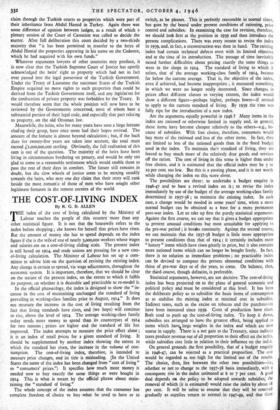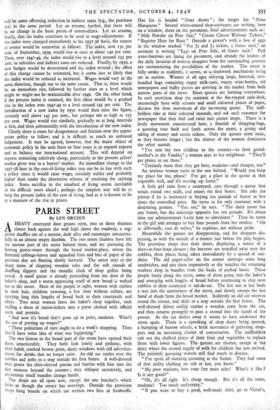THE COST-OF-LIVING INDEX
By R. G. D. ALLEN
THE index of the cost of living calculated by the Ministry of Labour touches the people of this country more than any other statistical figure. It is not that the housewife refers to the index before shopping ; she knows for her' self that prices have risen. But the amount of money she has to spend depends on the index figure if she is the wife of one of nearly 3,000,000 workers whose wages and salaries are on a cost-of-living sliding scale. The present index is still based on 1914, and trade unions are pressing for a new cost- of-living calculation. The Minister of Labour has set up a com- mittee to advise him on the question of revising the existing index. Any change is certain to spread,'via wage adjustments, throughout the economic system. It is important, therefore, that we should be clear on the nature of the present index, on the extent to which it fulfils its purpose, on whether it is desirable and practicable to re-model it.
In the official phraseology, the index is designed to show the " in- crease in the cost of maintaining unchanged the standard of living prevailing in working-class families prior to August, 1914." It does not measure the increase in the cost of living resulting from the fact that living standards have risen, and (we hope) will continue to rise, above the level of 1914. The average working-class family today needs more money to spend than its counterpart of 1914 for two reasons ; prices are higher and the standard of life has improved. The index attempts to measure the price effect alone ; it is an index of retail prices for a given standard of living. It should be supplemented by another index showing the extent to which the standard has risen, the increase in the volume of con= iumption. The cost-of-living index, therefore, is intended to measure price changes, and its title is misleading. gn the United States the name of the index has been changed from " cost of living " to " consumers' prices.") It specifies how much more money is needed now to buy exactly the same things as were bought in 1914. This is what is meant by the official phrase about main- taining the " standard of living."
The whole concept of the index assumes that the consumer has complete freedom of choice to buy twhat he used to have or to switch, as he pleases. This is perfectly reasonable in normal times, but goes by the board under present conditions of rationing, price control and subsidies. In examining the case for revision, therefore, we should look first at the position in 1939 and then introduce the present complications. There was every reason to revise the index in 1939, and, in fact, a reconstruction was then in hand. The existing index had certain technical defects even with its limited objective and at the time of its introduction. The passage of time inevitably raised further difficulties about pricing exactly the same things as were in the shops in 1914. The standard of living to which it refers, that of the average working-class family of 1914, became far below the current average. That is, the objective of the index, even if achieved, had become inappropriate• ; it measured something in which we were no longer really interested. Since changes in prices affect different classes to varying extents, the index would show a different figure—perhaps higher, perhaps lower—if revised to apply to the current standard of living. By 1939 the tine was fully ripe for the introduction of a new index.
Are the arguments equally powerful in 1946 ? Many items in the index are rationed' or otherwise limited in supply and, in general, these items have become cheaper relatively to the others---e.g., be- cause of subsidies. With free choice, therefore, consumers would buy more of the rationed and less of the other items. In fact, they are limited to less of the rationed goods than in the -fixed budget used in the index. To maintain their standard of living, they are forced to buy much more of the relatively dear goods and services off the ration. The cost of living in this sense is higher than under free choice, and it is estimated that the official index may be 5 to -to per cent. too low. But this is a passing phase, and it is not worth while changing the index on this score alone.
The possibilities are three: to undertake a budget enquiry in 1946-47 and to base a revised index on it ; to revise the index immediately by use of the budget of the average working-class family determined in 1937-38 ; to maintain the existing index. In each case, a change would be needed in some years' time, when a more normal budget can be obtained as a base for a more permanent post-war index. Let us take up first the purely statistical arguments. Against the first course, we can say that it gives a budget appropriate to present unusual conditions but most unsuitable for applying to the pre-war period ; it breaks continuity. Against the second course, we can maintain that the 1937-38 budget is little more appropriate to present conditions than that of 1914 ; it certainly includes more " luxury " items which have risen greatly in price, but it also contains more rationed items which can no longer be bought freely. In fact, there is no solution to immediate problems ; no practicable index can be devised to compare the present abnormal conditions with those of pre-war days or of the years to come. On balance, then, the third course, though defeatist, is preferable.
Statistical arguments, however, are not decisive. The cost-of-living index has been projected on to the plane of general economic and political policy and must be considered at this level. It has been the deliberate policy so to subsidise the basic items of consumption as to stabilise the existing index at minimal cost in -subsidies. Indirect taxes, such as the excise on tobacco and the purchase-tax have been increased since 1939. Costs of production have risen. Both tend to push up the cost-of-liiing index. -To keep it down, subsidies are arranged to have the greatest effect, being applied to items which have, large weights in the index and which, are now scarce in supply. There is a ner gain to the Treasury, since indirect taxes produce revenue out of all proportion to their effect on the index, while subsidies cost little in relation to their influence on the index.
On general grounds the first possibility, that of a budget enquiry in 1946-47, can be rejected as a practical proposition. The cost would be regarded as too high for the limited use of the results. The choice, then, lies between the other two possibilities—i.e., .whether or not to change to the 1937-38 basis immediately, with a consequent rise in the index estimated at 6 to 7 per cent. A good deal depends on the policy to be adopted towards subsidies; the removal of which (it is estimated) would raise the index by about 18 per cent. It will be safest to assume that they will be removed gradually as supplies return to normal in 1947-49, and that there •
will be some offsetting reduction in indirect taxes (e.g., the purchase tax) in the same period. Let us assume, further, that there will be no change in the basic prices of commodities. Let us assume, finally, that the index continues to be used in wage-adjustments. If the index were changed immediately to the 1937-38 basis, the course of events would be somewhat as follows. The index, now 132 per cent. of September, 1939, would rise at once to about 140 per cent. Then, over 1947-49, the index would rise to a level around 155 per cent. as subsidies and indirect taxes are reduced. Finally, by 1950, a new budget would be determined and the index revised ; the effect of this change cannot be estimated, but it seems just as likely that the index would be reduced as increased. Wages would vary in the same direction, though not to the same extent. That is, there would be an immediate rise, followed by further rises to a level which might or might not be maintainable after 1949. On the other hand, if the present index is retained, the first effect would be a gradual rise in the index over 1947-49 to a level around 145 per cent. The introduction of a new index by 1950 would then raise the figure, certainly well above 145 per cent., but perhaps not as high as 155 per cent. Wages would rise similarly, gradually or at long intervals at first, and then substantially with the introduction of the new index.
Clearly there is room for disagreement and friction over the appro- priate policy to follow, and it is difficult to reach an unbiased judgement. It may be agreed, however, that the major object of economic policy in the next three or four years is to expand exports and to balance our international account. This will depend on exports remaining relatively cheap, particularly as the present sellers' market gives way to a buyers' market. An immediate change to the 1937-38 base in the cost-of-living index may not be in line with such a policy since it would raise wages certainly earlier and probably higher than under the alternative scheme of retaining the existing index. Some sacrifice in the standard of living seems inevitable in the difficult years ahead ; perhaps the simplest way will be to keep the present index of the cost of living, bad as it is known to be as a measure of the rise in prices.































 Previous page
Previous page